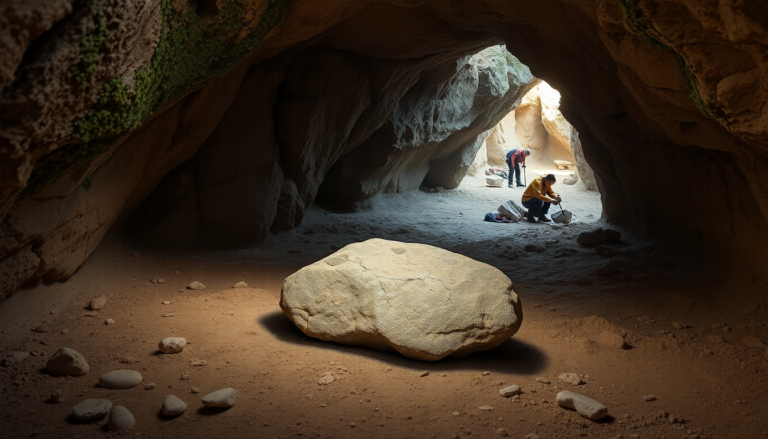Argomenti trattati
Recent archaeological discoveries are illuminating our understanding of prehistoric humans in ways we’ve never imagined. A striking find in Spain has sparked a conversation about the capabilities of Neanderthals, revealing a fascinating glimpse into their symbolic thinking. Unearthed from a rock shelter in Segovia, this 40,000-year-old stone is not just a relic; it represents a significant leap in our comprehension of Neanderthal culture and creativity.
The extraordinary find in Segovia
At the San Lázaro archaeological site in Segovia, researchers have uncovered a unique stone among the sediments of a rock shelter once inhabited by Neanderthal groups. This remarkable artifact, situated about 1.5 meters deep, features a distinctive red dot at its center. Unlike tools or weapons, this stone lacks practical functionality, suggesting it might have held symbolic or artistic significance. This intriguing feature has ignited discussions about the cognitive abilities of Neanderthals.
Unraveling the mystery of the red dot
Scientists believe the red color on the stone is not naturally occurring; rather, it is likely ochre pigment that was intentionally applied. The stone’s discovery marks the beginning of a deeper investigation into its origins. Advanced multispectral analyses, supported by Spanish forensic experts, revealed something even more astonishing: the dot was created with a finger, leaving behind a distinct fingerprint. This suggests that the creator was an adult male, possibly a prehistoric artist.
Symbolism and creativity of Neanderthals
The placement of the dot, strategically located at the center of a stone that resembles a face, implies a deliberate and meaningful gesture. María de Andrés-Herrero, a professor at the Complutense University of Madrid, highlighted how this stone serves as concrete evidence of the Neanderthals’ capacity for abstract and symbolic thought. This finding adds a new layer to the ongoing debate in archaeology: were Neanderthals capable of creating art?
Challenging established notions
For decades, scholars have grappled with the question of Neanderthal artistic ability. While evidence of engravings, decorated objects, and the use of pigments had emerged, definitive proof remained elusive. Now, this seemingly simple stone might hold the key to understanding Neanderthal artistry. The context in which it was found—clearly non-utilitarian—indicates that the act of creating the red dot was likely driven by aesthetic or ritualistic intention rather than practical necessity.
The significance of ochre
Analysis of the ochre pigment confirms that it was not naturally available at the site, suggesting that it was purposefully collected and transported. Gonzalo Santonja, an official representative of culture in Spain, remarked on the importance of this discovery, noting that it is the oldest known painted portable object in Europe, confidently attributed to Neanderthals. This small stone fragment, with its human fingerprint, symbolizes a deep-seated human impulse to express emotions, symbols, and visions—an impulse that predates what we once believed.
Reflections on our understanding of humanity
This remarkable find encourages us to rethink what we know about the cultural and cognitive abilities of our early ancestors. The implications of a Neanderthal artist challenge our perceptions of intelligence and creativity throughout human history. As we continue to unearth the past, each discovery like this one adds layers to our understanding of what it means to be human. It opens the door to further exploration into the world of Neanderthals and their capacity for symbolic thought, art, and perhaps a deeper connection to the human experience than we ever realized.

